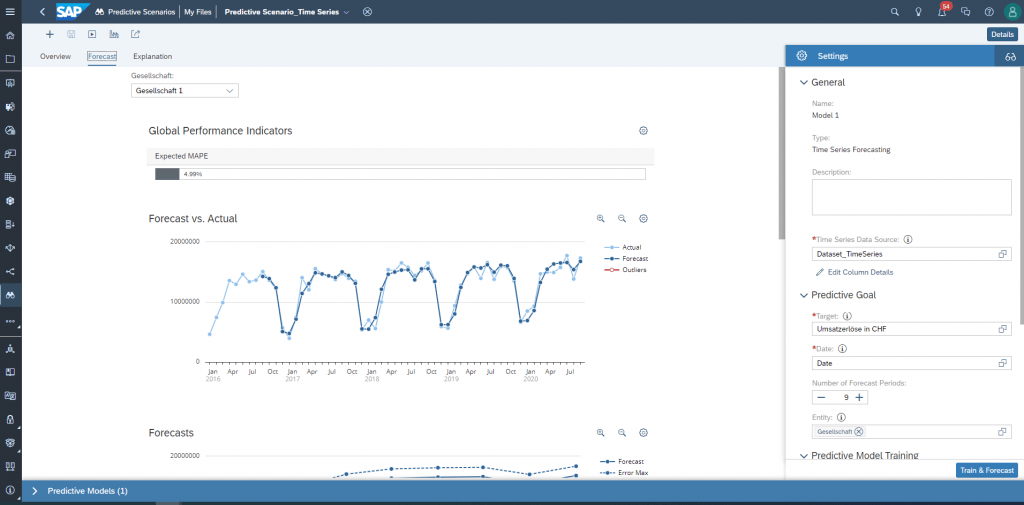From Planning to Customer Analytics to AI/ML
Predictive Analytics belongs to the subarea business analytics and deals with the prediction of future events., such as sales and demand forecasts.
Sales and Demand Planning Excellence
Through the analysis of historical data it is possible to events and and their probability can be predicted. This the company - e.g. the turnover or the demand - can be - plan with greater foresight and promptly react promptly.
Generate competitive advantage
Through forecasts and predictions with Predictive analytics can generate competitive generated can be generated.
Preventing bottlenecks and inefficiencies
Based on the forecast through Predictive analytics, insights into the optimisation of existing processes are to be achieved in order to prevent inefficiencies and bottlenecks.
A wide range of application examples
From the insurance industry to Predictive Maintenance of machines to to to the HR forecasting of employee failure probabilities.


What is predictive analytics?
Forecasting and planning are elementary aspects for sustainable business success. Companies are often faced with the challenge of, to make these processes more efficient and economical.
s-peers specifically addresses this situation with an AI-based approach that offers companies an optimal and efficiently automated forecasting solution: Predictive Analytics.
Artificial intelligence improves the results of planning and the planning processes themselves. This results in faster and more meaningful outcomes.
Predictive analytics provides better technical support for existing processes and relieves the responsible controllers and planners of their workload.
At the same time, the quality - accuracy and informative value - of the planning is increased by identifying cause-effect relationships (the drivers) and integrating them into the planning models.
Our definition of predictive analytics and differentiation from predictive modelling
Predictive analytics encompasses a variety of statistical techniques from different fields, such as data mining or machine learning.Predictive analytics often refers to a variant of predictive modelling is often meant,namely the forecasting of a future event.Predictive modelling can, however predict any kind of unknown event, even those without a time reference, as is the case with classification problems.
We at s-peers understand by predictive analytics the forecasting of future values or a time series on the basis of their historical values, such as the future development of the turnover of a sales outlet.
To achieve this goal, patterns in the data are recognised and used to mathematically model the time series. The historical data can also be enriched with additional data that can be beneficial for the modelling, such as business cycle indicators in the case of the turnover scenario.
The areas of application of predictive analytics are manifold. Predictive support is suitable for a wide range of business areas and fields of application. Established standard systems and processes exist for this purpose, which deliver very high data quality.
Predictive analytics is often used in in controlling and is therefore often called predictive controlling. In addition, controllers are usually very familiar with the targeted analysis of data: their core competencies have always included the planning, coordination and control of corporate goals - as well as the provision of decision-relevant information in a way that is appropriate for the target group.
Synonyms for Predictive Analytics are Predictive Modelling, Predictive Controlling,AI/ML and Big Data Analysis.
"With the Predictive Analytics Service from s-peers you get a State-of-the-Art forecasting system at hand, with which you can keep an eye on the future of your company. - und in a matter of seconds.
Dr. Eric Trumm, Head of Data Science and Innovation

How long does the implementation process take and what are the individual steps?
The implementation process depends on various factors and usually takes four-to-eight weeks. It consists of the following steps:
Ornamental setting
Requirements
Analysis of current situation
Design
Implementation
Implementation
In which system landscape will the solution be implemented?
- Python
- R
- Data management and analysis tool (such as the SAP Analytics Cloud)
The s-peers solution is independent of the customer system in every respect and can be offered both on-premise and as a cloud solution. As a rule, we use an R environment that can be adapted or connected to the customer's architecture.
Forecasts can be delivered via csv file or can also be fully automatically integrated into database solutions..
TOP 4: SAP Predictive Analytics Benefits that convince!
Precision
Precise forecasts in comparison with manualr activity
Fewer errors
GReduced susceptibility to error due to objective forecasts
Time saving
Time and cost savings due to the automated process.
Automation with AI
An AI-controlled forecasting system supports the gut feeling and can support underpin empirical values with analyses and figures.
